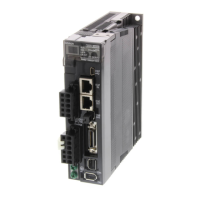3-56
3-3 Servomotor Specifications
OMNUC G5-Series AC Servo Drives Users Manual (Built-in MECHATROLINK-II communications type)
3
Specifications
Torque-Rotation Speed Characteristics for 1,000-r/min Motors
1,000-r/min motor (200/400 VAC)
The following graphs show the characteristics with a 3-m standard cable and a 200-VAC input.
• R88M-K90010H/T/F/C • R88M-K2K010H/T/F/C • R88M-K3K010H/T/F/C
(900 W) (2 kW) (3 kW)
Note:The continuous operation range is the range in which continuous operation is possible. Continuous operation at
the maximum speed is also possible. However, doing so will reduce the output torque.
Temperature Characteristics of the Motor and Mechanical System
OMNUC G5-Series AC Servomotors use rare earth magnets (neodymium-iron magnets). The
temperature coefficient for these magnets is approx. -0.13%/
C.
As the temperature drops, the motor's momentary maximum torque increases, and as the
temperature rises, the motor's momentary maximum torque decreases.
The momentary maximum torque rises by 4% at a normal temperature of 20
C compared to a
temperature of -10
C. Conversely, the momentary maximum torque decreases about 8% when
the magnet warms up to 80
C from the normal temperature.
Generally, when the temperature drops in a mechanical system, the friction torque and the load
torque increase. For that reason, overloading may occur at low temperatures.
In particular, in systems that use a Decelerator, the load torque at low temperatures may be nearly
twice as much as the load torque at normal temperatures.
Check whether overloading may occur during starting at low temperature.
Also check to see whether abnormal motor overheating or alarms occur at high temperatures.
An increase in load friction torque seemingly increases load inertia.
Therefore, even if the drive gains are adjusted at a normal temperature, the motor may not operate
properly at low temperatures. Check to see whether there is optimal operation even at low
temperatures.
10
0
20
19.3 (1800)
19.3
8.598.59
1000
2000
(r/min)
14.0
8.0
4.3
(1600)
Power supply voltage
dropped by 10%
Continuous operation range
Momentary operation range
(N • m)
25
0
50
1000
2000
(r/min)
19.119.1
47.7 (1600)47.7
28.0
18.0
9.6
(1400)
Power supply voltage
dropped by 10%
Continuous operation range
Momentary operation range
(N • m)
35
0
70
1000
2000
(r/min)
28.728.7
71.7 (1600)71.7
40.0
20.0
14.0
(1400)
Power supply voltage
dropped by 10%
(N • m)
Continuous operation range
Momentary operation range
